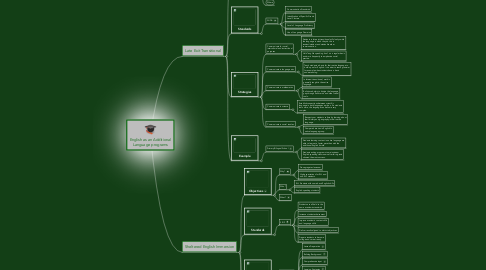
1. Sheltered English Immersion
1.1. Objectives
1.1.1. Why?
1.1.1.1. De-segragate classroom
1.1.1.2. High expectations for ELL and non-ELL students
1.1.2. Who?
1.1.2.1. ELL Students with some basic English skills
1.1.2.2. English-speaking students
1.1.3. What?
1.2. Standards
1.2.1. SIOP
1.2.1.1. Students are all held to the same academic standards
1.2.1.2. Increase student acheivement
1.2.1.3. Improve academic content skills and language skills
1.2.1.4. Deliver results aligned to district objectives.
1.2.1.5. Prepare students to become college and career ready.
1.3. Strategies
1.3.1. SIOP
1.3.1.1. Lesson Preparation
1.3.1.2. Building Background
1.3.1.3. Comprehensive Input
1.3.1.4. Learning Strategies
1.3.1.5. Interaction
1.3.1.6. Practice/Application
1.3.1.7. Lesson Delivery
1.3.1.8. Review/Assessment
1.4. Example
1.4.1. Brockton High School
1.4.1.1. All general education and immersion teachers trained in SIOP Model
1.4.1.2. Steady improvement of state standard (Massachusetts Comprehensive Assessment System) pass rate for ELLs in English language arts and math.
2. Late Exit Transitional
2.1. Objectives
2.1.1. Why?
2.1.1.1. Value both native language and English
2.1.2. Who?
2.1.2.1. ELLs who all speak the same native language.
2.1.3. What?
2.1.4. Why
2.1.5. Who?
2.1.6. What?
2.1.7. Who?
2.1.8. What
2.1.9. Where
2.2. Standards
2.2.1. WIDA
2.2.1.1. Communication Standards
2.2.1.2. Identification of Specific Grade Level Clusters
2.2.1.3. Level of Language Proficiency
2.2.1.4. Use of Language Domains
2.3. Strategies
2.3.1. Communicate for social, intercultural and instructional purposes
2.3.1.1. Students in late exit transitional will slowly switch the language in which they do this in student/student and student/teacher communication.
2.3.1.2. Hold "english speaking hour" on a regular basis and more frequently to emphasize social practice.
2.3.2. Communicate in language arts
2.3.2.1. Teach students a basis for their native language to build upon for English - it's easier to teach grammar for example when students have a basic understanding.
2.3.3. Communicate in mathematics
2.3.3.1. In late-exit transitional, math is generally taught in the native language.
2.3.3.2. Build vocabulary to bridge the language gap through flash cards and other visual tools.
2.3.4. Communicate in science
2.3.4.1. Establish connections between scientific language in both languages early-on. As students learn more, the language can become very complex.
2.3.5. Communicate in social studies.
2.3.5.1. Respect your students culture by learning about their history and geography in their native language.
2.3.5.2. Compare histories in English to native language group.
2.4. Example
2.4.1. Primary Bilingual School
2.4.1.1. Students learning content in native language are able to learn at a faster pace than with the additional English hurdle.
2.4.1.2. Students exiting programs to mainstream English-speaking classrooms after third grade showed the most success.

